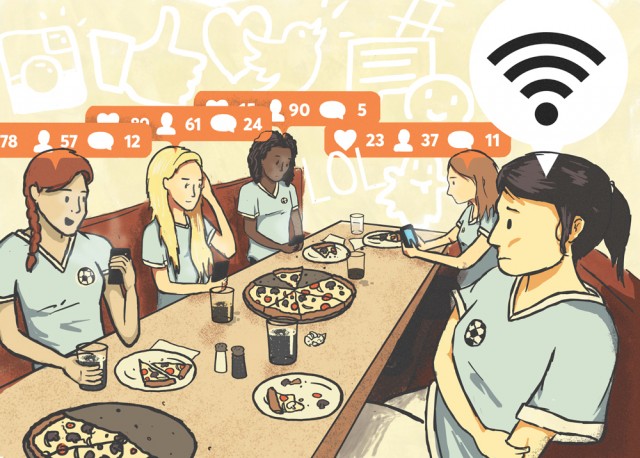The shaping power of technology
Have you heard of a kosher cellphone? Israel-based Rami Levy Communications introduced one in September 2013 for the ultra-orthodox Jewish community. These web-restricted phones are configured to align lifestyle with faith convictions.
“To apply for one,” reports Forbes.com, “you have to complete a form outlining your reasons for needing a smart phone, and secure the approval of your rabbi, whose name and phone number must be written down so that the company’s supervising rabbis can decide whether they think that you can be trusted to use it responsibly.”
You may never have considered adding your pastor’s name to your cellphone contract; however, the truth this Jewish community acknowledges also applies to Christians who aim to live faithfully: our mediums of communication matter. We do well to pay more attention to the mediums we choose as more and more of our faith experience is mediated by technology.
Acknowledge the influence
First, let’s acknowledge that channels of communication are not neutral.
Marshall McLuhan, one of Canada’s most iconic communication theorists, gave us the oft-quoted “The medium is the message.” We may use the phrase without really allowing its insight to penetrate our thinking and strategy. McLuhan was positing that technology will always shift a community’s environment and redefine relationships in the process. In other words, we choose our mediums, and then they shape us.
I enjoy taking note of congregations’ decisions around architecture, lighting and seating. McLuhan invites us to consider what frame of mind and physiological sensations these technological choices will prompt in our experience. How might these elements of form, rather than content, function to mediate God’s presence? Dark spaces with spotlight-dotted stages conjure profoundly different meanings than a platform arrayed in natural light from encircling windows. Don’t misunderstand my point here: I’m not disparaging stages and lights. But I do want you to notice that we are vulnerable to creating false expectations – for instance, for our congregations’ participation – when we fail to acknowledge the significant impact of form.
Communion with God is as much, if not more so, a sensory experience of our mediums of communication. Our choices send a message long before we begin to speak. Rather than being discouraged by this insight, I see this as an invitation to imagine how much we can offer a congregation by creatively orchestrating space, physical touch, movement and patterned practices of nonverbal interaction.
Pay attention to the results
Secondly, paying attention is a good idea because our technological choices have the potential to achieve unintended results.
Social psychologist Sherry Turkle points to the growing sense of isolation among adolescents, the most “connected” generation in world history. There is a bizarre irony that in an always-on cellphone era, youth are expressing a deep sense of loneliness.
When my 16-year-old daughter returned from a soccer wind-up party, I was surprised to hear her report it had been lonely. Eighteen teenagers at one big table at Boston Pizza could be lonely?! “Every single girl sat looking down at their smart phone screen all evening and literally the only time they looked up was the five minutes when the pizza arrived.” She described sitting alone in a crowd of “connected” teenagers.
There is always the potential for mediums to collapse on themselves. The very strength they offer, in this case, ease of connection, can actually reverse on itself. You may well argue that it wasn’t the screens that caused the Boston Pizza disconnect, it was people’s choices, and you would be correct. Technology is always a combination of hardware and behaviour.
But the “DNA” of some technologies pushes us in particular directions. When capitalist for-profit companies design our devices, their particular bottom line may not ultimately have to do with genuine shared meaning between humans. Enticing us to addictively browse their ad-driven content may be their aim. We shouldn’t easily dismiss the capacity of a design to disrupt or enhance our social experience.
A grandparent I met at church the other day isn’t being anti-technology when he creates a cell-free time with his grandchildren with a technology drop-off basket at the front door. The teenagers verbally express their deep appreciation, he says. It almost sounded like he helped them achieve something they value. We can help each other define what true connection is by risking to put limits on our technological choices.
Fuel imagination with the Word
Finally, I invite us to allow the incarnation to fuel our imagination as we adopt, adapt or reject a technology.
Technology choices in faith communities will always be informed by theology (our view of Scripture, our view of authority and our church tradition), argues communication theorist Heidi Campbell. Her work has helped me understand why conversations about kosher cellphones or the future of denominational print publications quickly become discussions about biblical peoplehood and authority. We are always negotiating core theological commitments when we harness technology. The fact that these questions arise in our strategic meetings signals a healthy disposition to be a biblically rooted community.
When I pick up my Bible to discern technology, I go to John 1:14: “The Word became flesh and made his dwelling among us.” Scripture has developed a strong incarnational bias in my view of technology! I can’t help but be amused when people comment that FaceTime or videocast sermons is very similar to face-to-face interaction: “You see them, you hear them, you connect – it’s basically the same!” But I’m also perplexed because my understanding of John 1:14 is that Jesus literally moved into the neighbourhood as fully embodied presence.
There is a fundamental qualitative difference between FaceTime and face to face; allowing our language to say anything less is a gross reductionism of the incarnation. There may be various valid rationales for why we would multicast our pastor, but one of them cannot be that it is an extension of his or her presence into the lives of more congregants.
Think of it this way: if John 1:14 read, “and the Word became a digital re-presentation of God delivered to us in two-dimensional pixelated (although HD) form,” we would quickly argue that that isn’t at all the same as “the Word became flesh and blood and moved into the neighbourhood” (The Message). Why then, do we fail to acknowledge this distinction in the way we speak about technology and in the way we implement our mission?
In my years as a radio broadcaster, John 1:14 always provoked me to humbly acknowledge the limitations of the medium even as I wholeheartedly pursued its missional potential. Let’s be clear: the capacity to digitally span geographical space with our content should never be equated with embodied relational intimacy.
By now, you may well have found yourself reacting very strongly to my prompts in relation to some of the things we all love: our technology. In fairly provocative terms, I invite you to consider whether mediums of communication are neutral, whether technology can lead to unexpected results and whether a high view of the incarnation provides a way forward in our technological choices.
As I consider these dynamics, I keep coming back to that kosher cellphone; perhaps adding my pastor’s name to my smart phone contract isn’t such a bad idea. This kind of intentionality can serve as the catalyst for life-giving creative action in our hurting world.
 David Balzer is a member of North Kildonan MB Church, Winnipeg, who teaches communication at Canadian Mennonite University. He is currently on a documentary film adventure to explore how and why people say “Oh my God” (omgthedoc.com). This article is a follow-up to “Beyond the next iPhone: The communication challenge and opportunity of our era” (October/November 2015).
David Balzer is a member of North Kildonan MB Church, Winnipeg, who teaches communication at Canadian Mennonite University. He is currently on a documentary film adventure to explore how and why people say “Oh my God” (omgthedoc.com). This article is a follow-up to “Beyond the next iPhone: The communication challenge and opportunity of our era” (October/November 2015).
Listen to David speak about his communication research on MBCM’s Multiply Podcast.
space | ||
| space | DiscussHow much accountability should we have to our spiritual family for our technology use? Would you allow your pastor to tell you how to use your smart phone? What messages do we send ourselves and others by the value we place on screen interactions versus in-person face time? What does the design of our corporate worship space say about how we expect to encounter God in that place? If there are there other places you prefer to go for a deep experience of God’s presence, what makes them special?
ToolboxWhen Religion Meets New Media, by Heidi Campbell (New York, NY: Routledge. 2010) More Than Talk: A Covenantal Approach to Everyday Communication (4th ed.), by Bill Strom. (Kendall Hunt Publishing Company. 2013) Alone Together: Why We Expect More from Technology and Less from Each Other, by Sherry Turkle. (New York, NY: Basic Books. 2011) | space |
| space |

1 comment
I had no idea how much the new technology has impacted Christianity until this weekend. The assembly I have attended for years, requests that brethren turn off (or at least set their cellphones to vibrate) during services. The songs of worship are accompanied by a piano & guitar, and a Bible occupies the pulpit.
I went into a different neighborhood church this last weekend, something I have not done for around 5 years. I was taken aback from the beginning when the singing began with a fully amplified rock & roll ensemble. Electric guitar, bass, keyboard, drums, all connected to amps, as were the microphones. The music was so loud I found myself flinching from the percussive damage that was being done to my eardrums. I tried to relax into the music, closed my eyes and listened. That was when I realized I could not hear any of the voices of the congregants, other than those on the stage. Not even those sitting beside, in front and behind me. My spirit was not at all uplifted, it was quenched, as my physical essence had to accommodate such an assault on the senses.
After the music ended, the sermon began. There was no request to the assembly to turn off their cellphones, and it quickly became apparent why. Those providing the sermon, were using their smart-phones and tablets to conduct the teaching. I looked around me, and noticed I was the only one within my vicinity with a physical old fashioned tome. Everyone’s bible was a battery powered device. I should mention, that I became aware of this not only due to my visual observation …
In such an environment, I would think it would very difficult, and more than likely considered hypocritical, not just for the pastor, but for parents to set restrictions on smart phone use.